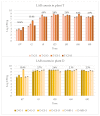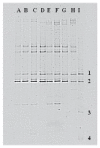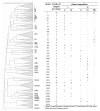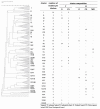Lactic Acid Bacteria: Variability Due to Different Pork Breeds, Breeding Systems and Fermented Sausage Production Technology
- PMID: 32183247
- PMCID: PMC7142627
- DOI: 10.3390/foods9030338
Lactic Acid Bacteria: Variability Due to Different Pork Breeds, Breeding Systems and Fermented Sausage Production Technology
Abstract
Changes in the ecology of the various lactic acid bacteria (LAB) species, which are involved in traditional fermented sausages, were investigated in the light of the use of different breeds of pork, each of which was raised in two different environments and processed using two different technologies. The semi-quantitative molecular method was applied in order to understand how the different species alternate over time, as well as their concentration ratios. A significant increase in LAB over the first days of fermentation characterized the trials where the starter culture wasn't added (T), reaching values of 107-108 cfu g-1. On the other hand, in the trials in which sausages were produced with starter addition, LAB counts had a less significant incremental jump from about 106 cfu g-1 (concentration of the inoculum) to 108 cfu g-1. Lactobacillus sakei and Lb. curvatus were detected as the prevalent population in all the observed fermentations. Pediococcus pentosaceus, Lb. casei, Leuconostoc mesenteroides, Lactococcus garviae, and Lb. graminis also appeared, but their concentration ratios varied depending on the diverse experimental settings. The results of cluster analysis showed that a plant- and breed-specific LAB ecology exists. In addition, it was also observed that the breeding system can influence the presence of certain LAB species.
Keywords: breed; breeding system; ecology; fermented sausages; lactic acid bacteria.
Conflict of interest statement
The authors declare no conflict of interest.
Figures




Similar articles
-
Catalase-positive cocci in fermented sausage: Variability due to different pork breeds, breeding systems and sausage production technology.Food Microbiol. 2012 Apr;29(2):178-86. doi: 10.1016/j.fm.2011.09.005. Epub 2011 Sep 22. Food Microbiol. 2012. PMID: 22202871
-
Lyophilized preparations of bacteriocinogenic Lactobacillus curvatus and Lactococcus lactis subsp. lactis as potential protective adjuncts to control Listeria monocytogenes in dry-fermented sausages.J Appl Microbiol. 2005;98(1):56-63. doi: 10.1111/j.1365-2672.2004.02419.x. J Appl Microbiol. 2005. PMID: 15610417
-
Dry Fermented Sausages with Total Replacement of Fat by Extra Virgin Olive Oil Emulsion and Indigenous Lactic Acid Bacteria.Food Technol Biotechnol. 2021 Sep;59(3):267-281. doi: 10.17113/ftb.59.03.21.7114. Food Technol Biotechnol. 2021. PMID: 34759759 Free PMC article.
-
Antibiotic resistance of lactic acid bacteria isolated from dry-fermented sausages.Int J Food Microbiol. 2015 Nov 6;212:76-88. doi: 10.1016/j.ijfoodmicro.2015.04.035. Epub 2015 Apr 29. Int J Food Microbiol. 2015. PMID: 26002560 Review.
-
Biodiversity and dynamics of meat fermentations: the contribution of molecular methods for a better comprehension of a complex ecosystem.Meat Sci. 2011 Nov;89(3):296-302. doi: 10.1016/j.meatsci.2011.04.011. Epub 2011 Apr 20. Meat Sci. 2011. PMID: 21555189 Review.
Cited by
-
The quality of Tibetan sheep meat from pastures was synergistically regulated by the rumen microbiota and related genes at different phenological stages.Front Vet Sci. 2025 Jan 7;11:1484175. doi: 10.3389/fvets.2024.1484175. eCollection 2024. Front Vet Sci. 2025. PMID: 39840335 Free PMC article.
-
Low-Fat and High-Quality Fermented Sausages.Microorganisms. 2020 Jul 10;8(7):1025. doi: 10.3390/microorganisms8071025. Microorganisms. 2020. PMID: 32664371 Free PMC article.
-
Taxonomical Identification and Safety Characterization of Lactobacillaceae from Mediterranean Natural Fermented Sausages.Foods. 2022 Sep 9;11(18):2776. doi: 10.3390/foods11182776. Foods. 2022. PMID: 36140904 Free PMC article.
-
The Use of Less Conventional Meats or Meat with High pH Can Lead to the Growth of Undesirable Microorganisms during Natural Meat Fermentation.Foods. 2020 Oct 1;9(10):1386. doi: 10.3390/foods9101386. Foods. 2020. PMID: 33019548 Free PMC article.
-
Sausages: Nutrition, Safety, Processing and Quality Improvement.Foods. 2021 Apr 19;10(4):890. doi: 10.3390/foods10040890. Foods. 2021. PMID: 33921562 Free PMC article.
References
-
- Cocolin L., Manzano M., Cantoni C., Comi G. Denaturing gradient gel electrophoresis analysis of the 16S rRNA gene V1 region to monitor dynamic changes in the bacterial population during fermentation of Italia sausages. Appl. Environ. Microbiol. 2001;67:5113–6282. doi: 10.1128/AEM.67.11.5113-5121.2001. - DOI - PMC - PubMed
-
- Lücke F.K. Fermented sausages. In: Wood B.J.B., editor. Microbiology of Fermented Food. Elsevier Applied Science; New York, NY, USA: 1985.
-
- Iacumin L., Osualdini M., Bovolenta S., Boscolo D., Chiesa L., Panseri S., Comi G. Microbial, chemico-physical and volatile aromatic compounds characterization of Pitina PGI, a peculiar sausage-like product of North East Italy. Meat Sci. 2020;162:108081. doi: 10.1016/j.meatsci.2020.108081. - DOI - PubMed
Grants and funding
LinkOut - more resources
Full Text Sources
Miscellaneous

